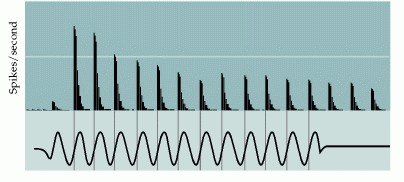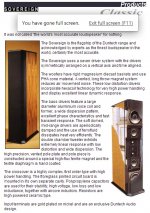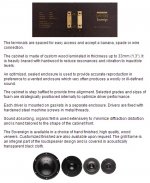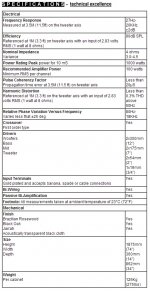Infinite low end extension also.Most loudspeakers cannot reproduce a reasonable facsimile of a square wave -- it takes very good phase response & very extended HF extension.
Accurate is also a very hard term to nail down.
dave
Dan.
Infinite low end extension also.
Dan.
Why would you need 'infinite low end extension' to reproduce a square wave?
The "roof" and "bottom" of a square wave are tilted when the latter is fed through a highpass. The closer to the cutoff frequency, the more it is tilted. And two octaves for instance can already be considered close. Thats why I doubt the 100 Hz measurement shown for the Rehdeko speaker. Apart from that: IIRC all Rehdeko speakers were reflex boxes which can't have such good square-wave reproduction at such low frequencies.
Regards
Charles
Regards
Charles
Dear All, i thank you very much indeed for all the very kind and valuable advice.
I have still one question, i swear the last one, even more basic than the original
Is it important that a driver (i.e. a woofer, a midrange or a tweeter) gives a good performance when asked to reproduce a square wave ?
My feeling is yes, but i would like to get some confirmations on this issue.
Because everything starts with the right selection of drivers
and the square wave test could be a very useful tool to perform this selection in my view.
Then after this we can talk about xovers.
Thanks again and kind regards,
gino
I have still one question, i swear the last one, even more basic than the original
Is it important that a driver (i.e. a woofer, a midrange or a tweeter) gives a good performance when asked to reproduce a square wave ?
My feeling is yes, but i would like to get some confirmations on this issue.
Because everything starts with the right selection of drivers
and the square wave test could be a very useful tool to perform this selection in my view.
Then after this we can talk about xovers.
Thanks again and kind regards,
gino
Is it important that a driver (i.e. a woofer, a midrange or a tweeter) gives a good performance when asked to reproduce a square wave ?
gino,
Some background on what a square wave is Square wave - Wikipedia, the free encyclopedia.
Due to their limited bandwidth nowoofer,mid, or tweeter have any hope of doing a square wave. A really extended full-range driver would have the best shot, but alas, even today's best full-range is still only a wide band driver, and would still have some tilt.
dave
gino,
Some background on what a square wave is Square wave - Wikipedia, the free encyclopedia.
Due to their limited bandwidth nowoofer,mid, or tweeter have any hope of doing a square wave.
Hi thanks and sorry if i am hard of understanding
But this applies also in their best range ?
I mean, a woofer has no chance to give a good 150 Hz square wave ?
I understand that outside its best working range will be poor ... but in its better range ?
Moreover ... what about a tweeter ?
If we agree that the square wave test is telling a bad behaviour should be a bad point.
A really extended full-range driver would have the best shot, but alas, even today's best full-range is still only a wide band driver, and would still have some tilt.
dave
Thanks and again if we agree about the importante to give back a decent square wave this is a very strong point for full range drivers.
Because one thing is to have some tilt another one is to have a not acceptable response.
After all these years i am open also to uncoventional options.
Very open ...
I am willing to rethink entirely my approach to system set up.
Thanks a lot again and kindest regards,
gino
P.S. lately i have concluded that a full understanding of drivers behaviour is fundamental to get decent performance
Maybe it is a little trivial for many but still ...
Last edited:
a woofer has no chance to give a good 150 Hz square wave ?
A square wave can be decompossed into a sin wave fundemental + an infinite number of odd harmonics...
so lets look at this woofer(hopefully my math is right... i should be in bed asleep).
150 Hz fundemental, then 600 Hz, then 2.4KHz, then 9.6kHz... it can't really do that last one, so with only 2 harmonics so we have a REALLY poor representation of a square wave...
amps that have good square waves have flat response from really low to really high (100+ kHz)
dave
the use of square waves for audio testing is very interesting specially at the end of the chain (speakers) , here is a very good thread from another forum:
Square Wave Response, Measured Acoustically
food for thought:
in one of the paragraph the OP writes
"none of my CD/DVD players could produce a decent square wave"
this can also be the case for vinyl:
if the most common sources for music are not accurate enough to produce a good square wave... hmmm ....
Square Wave Response, Measured Acoustically
food for thought:
in one of the paragraph the OP writes
"none of my CD/DVD players could produce a decent square wave"
this can also be the case for vinyl:
An externally hosted image should be here but it was not working when we last tested it.
An externally hosted image should be here but it was not working when we last tested it.
if the most common sources for music are not accurate enough to produce a good square wave... hmmm ....
It is vitally important that a CD record/replay chain cannot produce a "decent square wave". Being able to produce a square wave means that one or both of the anti-aliasing and reconstruction filters are missing or faulty.soyuz said:food for thought:
in one of the paragraph the OP writes
"none of my CD/DVD players could produce a decent square wave"
The issue is not 'accuracy' but filtering. You can't reproduce a square wave through any finite bandwidth system. All music sources have finite bandwidth. For music this is fine. For square waves this is disastrous. Hence naive square wave testing is unhelpful and misleading.if the most common sources for music are not accurate enough to produce a good square wave... hmmm ....
the use of square waves for audio testing is very interesting specially at the end of the chain (speakers) , here is a very good thread from another forum:
Square Wave Response, Measured Acoustically
Thanks a lot indeed for the very interesting link.
The picture in the first post looks quite good to me actually.
I mean there is a good resemblance between input and output, as it should in general
Not bad indeed.
food for thought:
in one of the paragraph the OP writes
"none of my CD/DVD players could produce a decent square wave"
this can also be the case for vinyl:
An externally hosted image should be here but it was not working when we last tested it.
An externally hosted image should be here but it was not working when we last tested it.
if the most common sources for music are not accurate enough to produce a good square wave... hmmm ....
Again i like very much the result. And i have been extremely surprised by the quality of a square wave obtained from a vinyl based system.
Very very good.
And this makes me even rethink in a positive way about the quality of this medium.
But i am now completely devoted to digital.
And you know what ? i am thinking to set up a little pc based scope for curiosity ...
Thanks a lot again.
Regards,
gino
Last edited:
To me a decent sqare-wave from a real-world system is one that has reasonably steep slopes and not too much over- or undershoot. Both square waves shown in the second last post (CD player and record player) are very fine examples IMO. Just have a look the square-wave response of >99% of loudspeakers: They reproduce more or less a caricature of a square wave.
Just have a look at figures 5 to 8:
Speaaker Transient Analysis
Regards
Charles
Just have a look at figures 5 to 8:
Speaaker Transient Analysis
Regards
Charles
To me a decent sqare-wave from a real-world system is one that has reasonably steep slopes and not too much over- or undershoot.
Both square waves shown in the second last post (CD player and record player) are very fine examples IMO. Just have a look the square-wave response of >99% of loudspeakers: They reproduce more or less a caricature of a square wave.
Just have a look at figures 5 to 8:
Speaaker Transient Analysis
Regards
Charles
Thanks a lot for the very interesting explanation
I think it is important to put the blame on the actual guilty component
We have two suspects here: the driver and the crossover before it.
If the driver is able to pass, even in a limited range of frequencies, a decent SW is, in that limited range, ok to me.
A crossover that is not able to pass a decent SW is surely not accurate and so questionable.
I feel that i will end with an active monitor one of these days ...
When i hear of a speakers very good with passive crossover i wonder how much better could it be with an active one.
My feeling is a lot better.
Thanks a lot again.
Kind regards, gino
Last edited:
What you listed looks like odd octaves.
Yes, it was. You are right. Thanx for the correction.
dave
There are many aspects to a loudpeaker and its crossover that are more important and audible than fidelity to the phase response of in the input signal (meaning the speaker "can reproduce a square wave").
That fact that a very well regarded loudspeaker can reproduce a square wave does not mean that a speaker that can not reproduce a square wave must there be a bad speaker. That Duntech loudspeaker probably got about 20 other things right, too.
That fact that a very well regarded loudspeaker can reproduce a square wave does not mean that a speaker that can not reproduce a square wave must there be a bad speaker. That Duntech loudspeaker probably got about 20 other things right, too.
Last edited:
For the most part, I agree, but there may be some potential, if a time aligned wavefront actually makes it to the listening location, for a more highly detailed, better integrated listening experience.
I would buy that EXCEPT: In the real world, unless we were listening to a point source radiator, as soon as you move your head, it all changes. This goes back to the idea that we are phase sensitive, which has been pretty well de-bunked, and the misunderstanding of how our ear works. We don't hear everything with one sensor, but with thousands of sensors each centered to different overlapping frequencies. So what a mic picks up is not representative of what our ear picks up.
Now, what is important about time/phase alignment is how it effects frequency response, lobeing, and image steering. Does a square wave aid in achieving results in this regard? Maybe. Something to think about at least.
Imaging is mostly defined by the close environment. Floyd Poole can describe it far better than I. By direct experience applying his advice, I went from vague imaging to doing a Chuck Jones eyeball double take when sounds came from outside the room.
Thanks a lot indeed for the very interesting link.
The picture in the first post looks quite good to me actually.
I mean there is a good resemblance between input and output, as it should in general
Not bad indeed.
Again i like very much the result. And i have been extremely surprised by the quality of a square wave obtained from a vinyl based system.
Very very good.
And this makes me even rethink in a positive way about the quality of this medium.
But i am now completely devoted to digital.
And you know what ? i am thinking to set up a little pc based scope for curiosity ...
Thanks a lot again.
Regards,
gino
As soon as you apply an integrator, you don't have a square wave.
As soon as you are not DC coupled, you don't have a square wave.
We don't hear steady pressure. In other words, not only do our systems not produce square waves, we can't hear them. We hear some set of frequency components that make up the square wave within the audible range.
I run Zelscope. Works quite well for LF. Of course, if you want to capture the full audio spectrum, then you need high speed acquisition. I use it mostly to measure acoustic centers and use my Tek for real work.
where?This goes back to the idea that we are phase sensitive, which has been pretty well de-bunked...
since it is wrong - though a really popular misapprehension among recording engineers - seems like "we don't pay attention to it therefore no one can hear it" backwards logic or rationalization
the basic physiology of hearing encodes absolute phase/polarity for input below a few kHz - maybe not in the old textbooks some learned from but it is textbook knowledge today
try auditory nerve fiber phase locking in search
The other prominent feature of hair cells—their ability to follow the waveform of low-frequency sounds—is also important in other more subtle aspects of auditory coding. As mentioned earlier, hair cells have biphasic response properties. Because hair cells release transmitter only when depolarized, auditory nerve fibers fire only during the positive phases of low-frequency sounds (Figure 13.10). The resultant “phase locking” that results provides temporal information from the two ears to neural centers that compare interaural time differences. The evaluation of interaural time differences provides a critical cue for sound localization, by means of which a person is able to perceive auditory “space.” That auditory space can be perceived in this way is especially remarkable, given that the cochlea, unlike the retina, cannot represent space directly.

10 Temporal response patterns of a low-frequency axon in the auditory nerve. The stimulus waveform is indicated beneath the histograms, which show the phase-locked responses to a 50-ms tone pulse of 260 Hz. Note that the spikes are all timed to the same phase of the sinusoidal stimulus. (After Kiang, 1984.)
Tuning and Timing in the Auditory Nerve - Neuroscience - NCBI Bookshelf
and careful researchers in audio have explored and found evidence in listening tests for much longer
AES E-Library On the Audibility of Midrange Phase Distortion in Audio Systems
Authors: Lipshitz, Stanley P.; Pocock, Mark; Vanderkooy, John
Affiliation: University of Waterloo, Waterloo, Ontario, Canada N2L 3Gl
JAES Volume 30 Issue 9 pp. 580-595; September 1982
Publication Date:September 1, 1982
The experiments conducted so far lead to a number of conclusions. 1) Even quite small midrange phase nonlinearities can be audible on suitably chosen signals. 2) Audibility is far greater on headphones than on loudspeakers. 3) Simple acoustic signals generated anechoically display clear phase audibility on headphones. 4) On normal music or speech signals phase distortion appears not to be generally audible, although it was heard with 99% confidence on some recorded vocal material.
some might find it interesting that even harmonics giving rise to waveform asymmetry allows for easier detection of relative phase shift between the fundamental and the harmonics
Last edited:
There are many aspects to a loudpeaker and its crossover that are more important and audible than fidelity to the phase response of in the input signal (meaning the speaker "can reproduce a square wave").
That fact that a very well regarded loudspeaker can reproduce a square wave does not mean that a speaker that can not reproduce a square wave must there be a bad speaker. That Duntech loudspeaker probably got about 20 other things right, too.



SOVEREIGN
Dan.
- Status
- This old topic is closed. If you want to reopen this topic, contact a moderator using the "Report Post" button.
- Home
- Member Areas
- The Lounge
- Square wave test on speakers - what does it tell ?